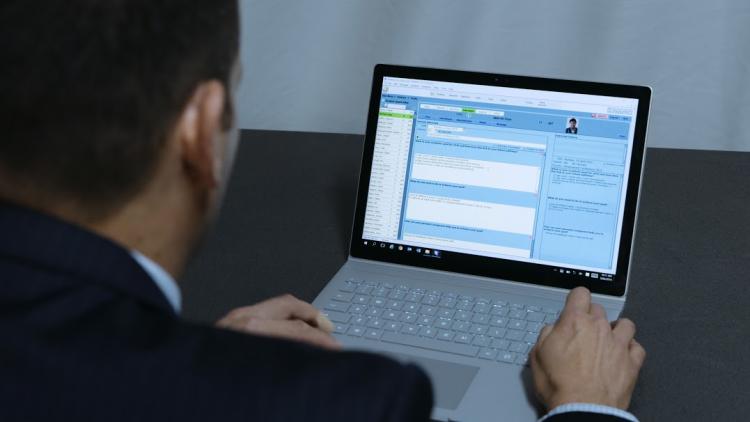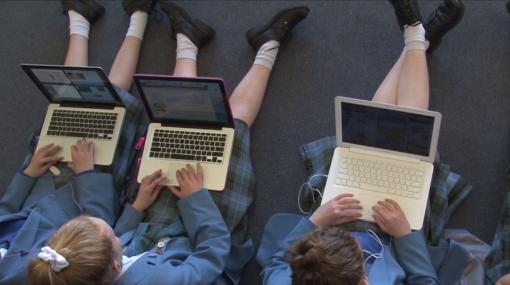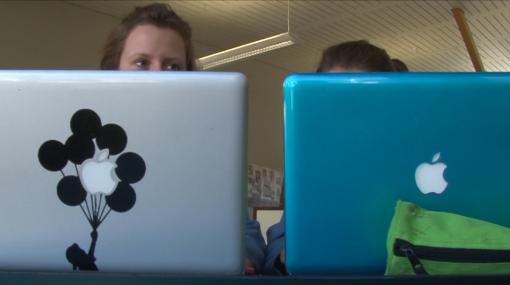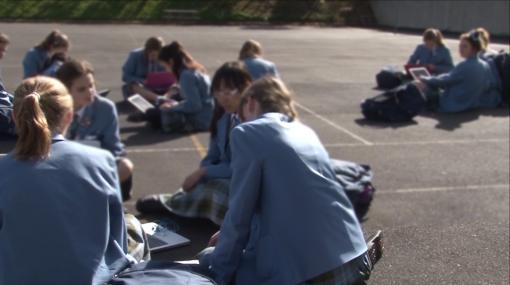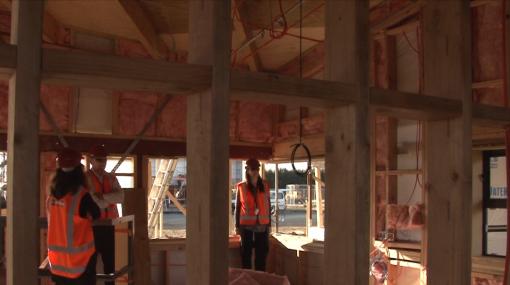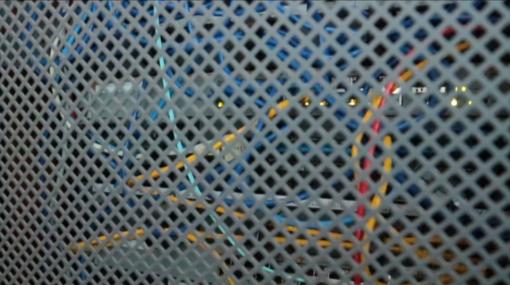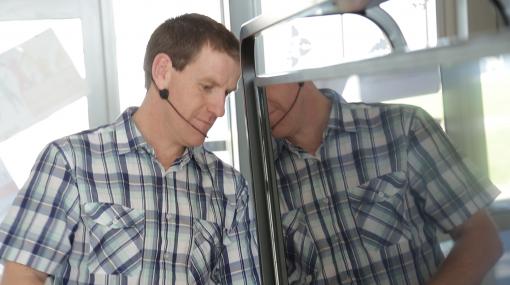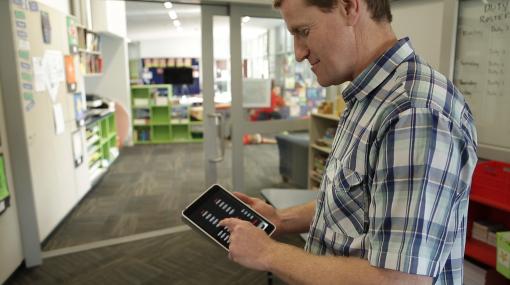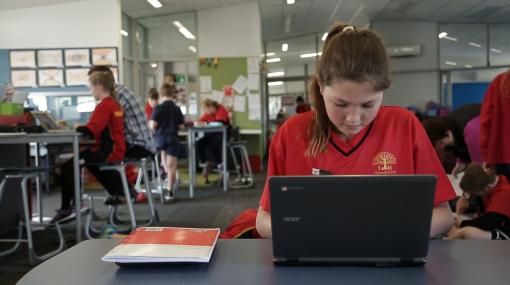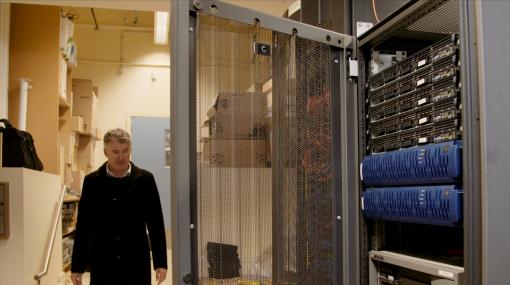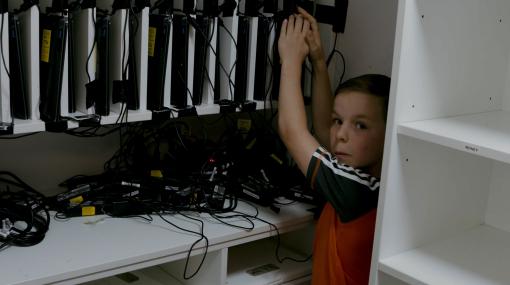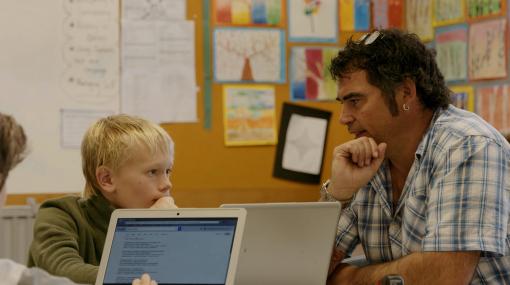Infrastructure
Infrastructure is the term given to your digital systems as a whole including the hardware, software and configuration of servers, cables, wires, desktops, laptops, and so on, as well as the systems and processes followed by the people who manage them.
Principal Jane Danielson shares the thinking that went into planning their technological infrastructure at Hingaia Penninsula School.
Reviewing and upgrading your infrastructure
Regular reviews of your technology infrastructure ensure that the needs of learners and staff are being met, and any risks or irritations are kept to a minimum. It is recommended that an annual review of your technology, including your infrastructure, is carried out.
More information »
Technical support
The ICT helpdesk for schools provides first-level support for all schools regarding hardware and software issues. They are open for calls from principals, teachers, and school IT specialists. They enjoy helping non-technical people with their technical problems. Level 1 support is provided for a range of software applications such as Microsoft Office and Symantec.
- Call 0800 CALL ICT
- or 0800 225 542- Option 5 MoE ICT Helpdesk
- 7:00am–7:00pm, Monday to Friday (excluding public holidays)
Email: [email protected]
N4L can assist with any firewall, web filter or network infrastructure queries:
- Call 0800 LEARNING
- Email: [email protected]
For TELA Laptops enquiries:
- Call 0800 438 468
- Email: [email protected]
- TELA+ digital devices page on the Ministry of Education's website
Visit the Technology for learning section of the education.govt.nz website for more information, news, and updates about Ministry funded programmes including Software for your school .
Ministry of Education services and upgrades
Your local school infrastructure connects you to a wider infrastructure including the Network for Learning (N4L) School Network . N4L provides all schools with Government funded access to reliable, fast, safe internet connections with uncapped data. The N4L School Network is part of the nationwide School Network Upgrade that delivers the Ministry of Education’s Te Mana Tūhono programme – providing long-term IT support.
Maintaining your upgraded ICT network
- Your school's ICT network – Ways to maintain your upgraded ICT network and provides information about the Ministry of Education’s programme of work.
- Maintain your upgraded ICT network – All schools have had their ICT infrastructure upgraded through the School Network Upgrade Project (SNUP). Schools are responsible for keeping their ICT network maintained to the current Ministry standard.
Schools as digital hubs
Schools with ultra-fast broadband can share their internet with the local community, making a digital hub.
More information »
Wifi safety in schools
Concerns about the safe use of WiFi in schools occasionally arise. The Ministry of Education seeks expert advice from the Ministry of Health on all matters related to health. The Ministry of Health has affirmed its position that exposure to radioactive fields from WiFi equipment in schools does not pose a health risk to staff or students in the area where it is used.
Measurements in New Zealand and overseas show that exposures to radiofrequency fields from WiFi equipment are extremely low, amounting to tiny fractions of the limit allowed for the public in the New Zealand radio frequency field exposure standard .
More information »
- WiFi networks – Ministry of Health information
- WiFi information for schools – Information for parents (PDF) - Ministry of Education flyer.
Firewalling and internet filtering, along with an effective digital citizenship strategy, are the primary means by which schools ensure the digital safety of learners.
What is a firewall?
Firewalls are specialised computers, placed at the edge of a computer network, that control and monitor the internet traffic that enters and leaves the network. In simple terms, firewalls prevent unwanted internet traffic from entering a computer network while simultaneously allowing permitted traffic to leave.
Firewalls are the main defence against online cracking and unauthorised access to computers connected to the school network. In Aotearoa, a firewall is implemented and maintained automatically by N4L at no cost to schools. This support includes configuration changes and software and hardware upgrades.
What is web filtering?
Web filters work by sending internet traffic through a specialised device that inspects what internet sites are being requested by the user. The filter checks each request against a set of policies that have been defined for each school (or group or user if group/user filtering is in place) and accordingly allows or rejects the request. This process is usually invisible to the end-user.
For most schools in Aotearoa, the web filters are implemented and maintained automatically by N4L. Individual schools can contact N4L and tweak filters to block or allow certain sites based on the needs of users at that school. It has the ability to filter based on individual sites, categories of sites (for example, gambling) and IP addresses. These filters can be applied to individuals or groups of devices and individuals or groups of people.
Schools have internet filtering for two main reasons:
- To help prevent access to sites and applications not appropriate to a school environment.
- To help prevent sites or applications that act as a source of distraction or time-wasting.
Schools working in partnership with N4L
N4L is keen to work with schools that may require custom or specialised firewalling and will work to ensure the N4L service meets their needs.
Schools may make requests of N4L to change firewall rules. For example, a school may require an on-site server to be capable of being accessed from the internet. N4L actions these change requests quickly, but also audits them to ensure they achieve their intended purpose securely.
N4L has expertise and experience in working with schools to ensure their internet and firewalling needs are met and that they support teaching and learning. The N4L service, because it is a managed service, has some unique advantages that a custom firewall does not have:
- The firewall rules that N4L implement as standard mean that common applications such as Google Hangouts, video-conferencing, and Skype will not require extra configuration by your school.
- Teachers and students are more likely to be able to use the applications or sites they want without requiring technical support or intervention.
- If a change is made by a service provider (for example, Apple, Google, or Microsoft) that will require a firewall change to be made, the N4L will make those changes on your behalf in order to ensure that teaching and learning can continue.
More information »
Web filtering considerations and the importance of digital citizenship
Responsibilities of schools
Schools have a responsibility to ensure that students are safe when using the internet. How individual schools do this will vary but it requires a combination of two complementary approaches:
- Educational (digital citizenship): guiding young people’s learning in the digital world.
- Protective (web filtering): mitigating or buffering risk by blocking undesirable web traffic.
Web filtering must be balanced with educational strategies that promote:
- developing skills and knowledge for safe and responsible use of digital technologies
- opportunities for students to be involved in decision-making about how digital technologies are managed
- developing a pro-social culture of digital technology use
- cooperation of the whole community in preventing and responding to incidents.
The New Zealand Curriculum’s Key Competencies are also relevant to how schools approach this topic.
The Code of Professional Responsibility and Standards for the Teaching Profession requires teachers to “Manage the learning setting to … maximise learners’ physical, social, cultural, and emotional safety”.
Internet access on student devices
Schools used to be confident that students’ access to the Internet was always through the school’s connection while they were at school. This connection was often faster than students’ home connections. Typically the school firewalled and filtered the connection. Students were protected while at school and it also gave the school a degree of protection. It was clearly seen as proactive and acting responsibly.
The availability of mobile data connectivity means that this approach is no longer effective, particularly in secondary schools. A device can access the internet at speeds similar to or faster than the speed offered by the school’s network. The connection can be shared with others by creating a wireless hotspot. In almost all cases, the mobile data connection will be unfiltered.
Schools have a responsibility to ensure students are safe while at school and this responsibility extends to student use of mobile data connections. Additionally, unless it is clearly endangering the emotional or physical safety of other students or detrimentally affecting the learning environment, school staff cannot ask to search a student-owned device, nor ask for the password to any device to access the content.
Schools cannot easily monitor the use of mobile internet access, so the only way to ensure the school meets its digital safety obligations is to implement a comprehensive digital citizenship strategy. This is because effective digital citizenship:
- guides people at home and at school
- guides people on mobile data or school Internet connection
- guides people on any device they choose to use.
More information »
- Safe and Responsible use of Digital Technologies in schools – Ministry of Education’s guidelines
What role does Internet filtering have in a digital citizenship strategy?
An appropriate level of internet filtering can help students develop Key Competencies and be a useful part of a digital citizenship strategy by:
- providing learners with opportunities to exercise digital citizenship skills in a supportive yet safe environment
- encouraging learners to use the school’s internet connection while at school, rather than using unfiltered, personal mobile data connections
- using the reporting functions of your filtering solution to prompt conversations about online behaviour with users.
Managing self – what does it really look like?
In the context of digital technologies, a student who is able to manage themselves will be able to:
- manage their time so that it is used efficiently and productively
- know the difference between appropriate and inappropriate content, that this varies contextually and make good decisions based upon the context
- actively make decisions to "do the right thing".
Older learners should be able to manage themselves more effectively than younger learners and be more discerning about what self-management means for themselves in different contexts. Using your filtering reporting tools to inform conversations with learners about how they manage themselves can be a useful technique to allow students to increase their ability to be discerning digital citizens.
More information
Devices need to be deployed and customised to operate in the school environment. Deployment involves resetting or reloading the operating system so it is clean of any previous customisations. The device can then be customised for the specific school or classroom. Customisation can involve configuring wifi or printer settings, installing apps/software, naming the device, setting desktop or screensaver images, or enforcing technical policies.
School devices need to be managed. There is ongoing intervention needed to maintain a device such as tracking it, providing or checking security updates, or adding and removing apps/software.
How deployment, customisation, and management has changed
Digital devices in schools used to be mainly desktop computers and laptops deployed, customised, and managed on a network using a server. This has changed significantly through a number of developments.
- A move towards ongoing, more regular updates – Software and operating systems update every few months rather than on a three to five-year refresh cycle.
- A greater variety of device types and operating systems that schools want to deploy and manage: Microsoft Windows, Apple’s MacOS, iPads, Chromebooks, Android tablets, Linux, and others.
- The expectation that people should be able to have a more configurable, personal user experience on any device and at any location, rather than a generic or technically-determined one.
- The desire for devices to be available for use at all times rather than having to be out of action while being reconfigured.
- People wanting to get the benefit of new functionality, apps, or updates as soon as they are available instead of having to wait for them to be made available through technical support.
- Schools seeking greater cost-effectiveness by moving away from having to procure and manage on-premise servers towards using cloud-based services on monthly subscriptions or no-cost basis.
Once the number of devices exceeds ten it is not generally recommended to carry out deployment and maintenance manually.
Automation using a Mobile Device Manager (MDM)
There are many cloud-based Mobile Device Managers (MDMs) available. Microsoft, Google, and Apple all support and recommend cloud-based MDM approaches for their operating systems. It is recommended that schools consider one or more MDMs to help with the deployment, customisation, and ongoing management of their devices.
Mobile device managers typically offer similar features and benefits. Each MDM will vary, though, in the features they have available and how they work, so it will be essential to check them out carefully before making a decision about what to use.
Typical features
- An inventory/asset register of attributes such as devices’ serial numbers, names and locations.
- A view of the apps/software, settings and security updates that are running on devices.
- The ability to remotely configure apps/software, scripts and settings in an automated way.
- Scalability from a few devices to a few thousand.
Common benefits
- Users and groups can have their experience customised based on their specific needs.
- Customisations like new apps/software, updates, scripts, and settings can be made readily and on the fly in an agile, automated way whenever changes are needed.
- Analysis of device usage can inform decisions around future device purchases and deployments.
- The location of devices can be determined if devices go missing.
- Administrators can check that the right apps/software, updates, scripts, and settings have been properly installed on devices to ensure their usability and security.
- The hands-off approach made possible by MDMs should save time and means changes can be done more easily and cheaply.
- People’s experience when using devices should be reliable and consistent which will increase their readiness to use them.
Can one MDM system manage all types of devices?
Microsoft and Apple have both opened their operating systems to being managed by third-party MDMs whereas Google’s devices can only be managed by the Google Admin Console using the Chrome Education License.
Using the same MDM system to manage both your Apple and Microsoft devices should be considered as this will reduce the number of tools that need to be learnt, accessed, and paid for.
What costs are involved to use an MDM?
Subscription costs
MDMs are typically purchased on a monthly subscription basis, although some are at no cost, including options available in the Ministry’s Microsoft Schools Agreement. The cost of the MDM should be considered alongside the alternative (if it exists) of purchasing and running a server and software to manage the devices at your school. Simplifying the management of devices with MDMs should lead to cost savings through reduced technical support time.
Technical support costs
Configuring and managing an MDM is technically involved. You should work with a technical support company to give you assistance with the initial configuration. Once set up, using the MDM should be easy enough with some training and familiarisation.
Using the capabilities of the MDM to proactively manage devices requires somebody to be responsible for the monitoring of the information that the MDM provides; installing an MDM, and then having nobody responsible to monitor it would be a waste of time and money. The monitoring could be done by a school support staff member or a technical support provider.
Which devices should you manage using an MDM?
School-owned devices
School-owned devices should be enrolled in an MDM given the benefits outlined above.
TELA+ digital devices
There are also advantages to using an MDM for TELA+ digital devices – in particular the ability to confirm whether the devices are running the latest security updates. However, the advantages may not be considered to be worth the cost of the MDM and it’s related support costs.
TELA+ can support schools in using Apple’s Device Enrolment Programme and Microsoft’s AutoPilot which allow a device to be automatically enrolled in the school’s MDM before it ships to the school. Google’s Chrome Education License is available at no cost through the Google School’s Agreement.
Student or teacher owned devices
Careful consideration is needed to determine whether students’ devices should be enrolled and managed by an MDM. Some factors to explore include:
- Cost/benefit ratio: is the financial outlay of the MDM worth the benefits of having student devices managed?
- Demarcation: by enrolling a device in an MDM, the school has some control over that device. The school may not want to have this increased responsibility.
Making the MDM optional for students and pointing out the advantages of using it may be a suitable approach.
Can we change from one MDM to another?
As MDMs are managing settings that have been enabled on the operating system, they tend to be differentiated on price and their user interface rather than on what settings they are capable of configuring. This means there is little risk of a school being locked into a particular MDM solution with a proprietary configuration.
You should expect a similar amount of work to move from one MDM to another as was involved in setting up your original MDM.
Considerations for choosing an MDM
Talk to other schools and your technical support provider to ask for recommendations.
There are many MDM options on the market. Our recommendation is to consider a product that is proven to work well in schools in New Zealand, and that offers features and support most relevant for you at the right price.
At the end of the year in most classrooms, students take home at least some of their paperwork for posterity but what does this look like for their digital work?
Having clear systems and procedures gives everybody confidence about what is going to happen to their digital data and accounts and what they need to do to avoid losing anything that they might need in future.
Who owns the data?
Staff and student data is treated differently in terms of copyright and ownership.
Staff
New Zealand teachers don’t, as employees, hold first ownership of copyright to resources they create in the course of their employment. The 1994 Copyright Act grants first ownership to employers, which in the case of New Zealand schools is the Board of Trustees (BoT).
Legally, teachers cannot take documents they have created as part of their employment with the school with them. However, we work in an environment of sharing and collaboration and so your school could consider adopting a Creative Commons Policy which will give teachers advance permission to take their resources with them and share them online.
In terms of documents saved in Google’s G Suite or Microsoft’s Office 365 accounts, the school should maintain access to them and should not delete them. This could be done by transferring ownership of the data to a generic account created for this purpose such as [email protected].
Students
Students own their own data so can take it away when they move on. As a school, develop a common understanding about the value of students owning their learning and the online identity that they might have built up through their blogs, e-portfolios and other activities that make up their digital footprint.
Further reading about copyright and ownership
- Your teachers’ work – TKI page outlining copyright issues surrounding the work of teachers in your school.
- Creative Commons in Schools – Outlines what CC is and how to pass a CC policy at your school
- Your students' work – TKI page outlining issues that school should be aware of surrounding copyright ownership of students' work, the rights of students, schools and teachers.
Managing user accounts when people leave your school
When an account for a service like G Suite, Office 365, Seesaw is deleted, any files, folders, emails, and calendars that a student or staff member has created are also deleted so it is important to consider:
- what content needs to be retained by the school
- what needs to be downloaded or transferred to that person
- what should be archived.
Rather than deleting accounts, they could be suspended which means that the shared content is still accessible to others but the user themselves can not log on to retrieve it and things like email and calendar invitations no longer work.
Alternatively, when a person leaves the school, ownership of their files could be transferred to another account such as a generic account or to a particular individual.
Another idea is to rename the user who is leaving to “deleted_(name of ex-account)”, change the password and disable the email for that account. This allows the original account name to be reused for a new staff member or student.
Migrating data when people leave your school
There are two key ways to migrate data when people leave the school.
- Downloading data – allows a copy of the data to be stored on a hard drive or memory stick and then uploaded or imported to a new account later.
- Transferring data – means that its ownership changes to a different account. This could be as simple as changing the email address associated with the old account to a new one. This option can be easier than downloading and importing but may not be available for all online services.
Schools should be prepared to hold data and keep it available until the students or staff that are leaving have a new account to transfer it to. Where possible, your school and the new school should work together to ensure that accounts overlap for a reasonable period of time.
Downloading data from Google’s G Suite, Microsoft’s Office 365, or Seesaw
Online services typically provide an option to download or export data.
G Suite
- How to download your Google data – Instructions from Google Support
- Google Takeout – Export a copy of content in your Google Account to back it up or use it with a service outside of Google
Office 365
- Download files and folders from OneDrive or SharePoint
- Export or backup email, contacts, and calendar to an Outlook .pst file
Seesaw
Transferring data from Google’s G Suite, Microsoft’s Office 365, or Seesaw
G Suite
- Transfer data between G Suite accounts
–
Google outlines options for administrators.
- Copy content from your school account to another account
– Procedure for students and teachers to use.
- Transfer your content – "Transfer Your Content" is only available to authorised G Suite for Education Accounts. A student or teacher visits their Transfer your content page. Note that only Drive files that the student or teacher is an owner of are transferred, not items that are shared with the account.
- VaultMe – A paid service that can transfer data between G Suite accounts and keep shared document settings in place.
Office 365
- Get access to and back up a former user's data – "How to" help for administrators.
Seesaw
- Can Seesaw journals follow students from year to year? – Seesaw only allows data to be transferred if you subscribe to Seesaw for Schools as explained in this support content.
Recommendations for migrating data from other services, including how to download and transfer
Blogger
How to download
- Use Google Takeout to export the posts as an XML file then import into a new account .
- Use Blog Booker to export your blog to a PDF.
How to transfer
- Follow the instructions to Move a blog to a new owner or watch this YouTube clip .
Recommendations
- In general, it makes sense to transfer ownership of the blog to the new Google account.
- Consider how blogs are initially created and managed within your school domain as this will impact transferring data when students or staff leave. Pt England School’s effective blogging site provides many recommendations.
YouTube
How to download
- Use the Video Manager to download some of your videos or use Google Takeout to download all your videos as MP4 files. Then upload them into the new account.
How to transfer
- It is not possible to transfer ownership of a YouTube clip or channel.
Recommendations
- Download your YouTube clips using Video Manager or Takeout.
Gmail
How to download
- Use Google Takeout to export your email to an MBOX file. This format can not easily be imported into your new Google account. Instead, use a programme like Mozilla Thunderbird to refer back to your old emails.
- Use a paid service such as VaultMe .
How to transfer
- Use the copy and transfer method.
Recommendations
- Use the copy and transfer method.
Chrome bookmarks
How to download
- Use Google Takeout to export your bookmarks as an HTML file then import them into your new account using the Chrome Browser.
How to transfer
- It is not possible to transfer ownership of bookmarks
Recommendations
- Use Takeout to download your bookmarks then import them into your new account.
Calendar
How to download
- Use Google Takeout to export your calendars as an ICS (iCalendar) file then import the events into your new Google account .
- Use the Calendar export utility in the Calendar Settings.
How to transfer
- Your existing calendars can be shared with your new account but their ownership can not be transferred.
- Use a paid service such as Cloud Gopher
Recommendations
- Use Takeout to keep a record of your calendar entries but use fresh, new calendars in your new account. Make a note of any shared calendars that you subscribe to and re-subscribe to them in your new account.
Contacts
How to download
- Use Google Takeout to export your contacts as a Vcard, HTML or CSV file then import your contacts into your new Google Account
How to transfer
- While contacts can be delegated (shared) within your school, they can’t be shared outside of your school. Instead, use a paid service such as Cloud Gopher .
Recommendations
- Use Takeout to export contacts as a CSV then import them into your new account.
Sites
How to download
- Google does not provide in-built tools to download the data in a Google site. Instead, use a website copier tool such as HTTrack or Site Sucker to take a copy of the pages.
How to transfer
- Either follow the instructions to Share your site with other people so that your new Google account becomes the site owner. The site will remain in place as it is currently with the School having overall administrative control of it.
- Or, you can follow the instructions to Share your site with other people so that your new Google account becomes the site owner and then make a copy of the site . This means the site takes on a new URL and is "budded" from the original one rather than transferred. You might wish to then delete the existing site – Leigh Hynes explained how in this YouTube clip – Transferring sites .
Recommendations
- Use one of the methods to transfer the ownership of your sites to your new account. Unless you want the site to remain under the control of your existing school, it is usually best to transfer ownership and make a copy of it.
Drive
How to download
- Use Google Takeout to export and download the Drive files that you are an owner of. This does not export and download files that are shared with you, though. You would have to make a copy of any files that are shared with you in order to download them with Google Takeout. Takeout exports Google Docs, Slides, Sheets as Microsoft Word, Powerpoint or Excel files. Google Forms are not downloaded at all and revision history and some formatting might be lost in the conversion.
- Another option is to move all your files and folders into a new folder which you then download. Downloading a folder means that files and folders that are shared with you are included in the downloaded ZIP file. Depending on the size of all files this could take some time to download so ensure your internet connection is good and the device being used is not going to go to sleep! You may like to download individual folders rather than everything in one hit. Once downloaded, the zipped folders need to be unzipped then the folder can be uploaded to the new account's Drive.
How to transfer
- Use the copy and transfer method which means sharing permissions will be lost.
- Use a paid service such as VaultMe which will maintain the sharing permissions of shared files and folders.
Recommendations
- Use the copy and transfer method.
More information »
Managing student and teacher data – Information from the Ministry's website on using Student Record Transfer (SRT) and sharing data from your Student Management Systems (SMS).
Te Rito (Student Information Sharing) – Te Rito involves the development of a national repository of learner data that enables the safe and secure transfer of information between schools and the sector.
Sorry, no items found.






